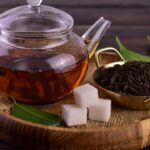Earl Grey tea contains moderate amounts of caffeine. The caffeine content of Earl Grey tea varies depending on many factors, mainly what tea is used as a base for this blend.
I’ll go over the caffeine content of Earl Grey tea in detail. Before that, here are some brief facts about this popular tea blend.
Earl Grey is a black tea flavored with bergamot, a pear-shaped citrus fruit about the size of an orange that is grown throughout the Mediterranean.
This popular tea blend usually uses black tea as a base, flavored with oil from the rind of bergamot orange. Some brands use bergamot peel and other dried fruit mixes and flowers too.
Calabria, in southern Italy, accounts for 80% of commercially grown bergamot, followed by France and Turkey. Rose petals, lavender, blue mallow flowers, and various citrus fruits are the most common ingredients added to the new Earl Grey blends.
Traditional Earl Grey tea is scented rather than flavored, with no other ingredients added to the blend. Just black tea flavored with bergamot oil. In the US, it is typically served with milk and sugar, whereas in the UK, it is typically served with lemon and sugar.
The global Earl Grey tea market reached a volume of 6.5 million tons in 2020. Due to the growing demand for organic products, the market is expected to grow at a CAGR of 3.5% in the forecast period of 2022–2027.
Now let’s see how much caffeine is in a typical cup of this tea.
Earl Grey Tea Caffeine Content
Every cup of traditional Earl Grey tea contains caffeine. When I say traditional, I mean Earl Grey with black tea as a base. Today, there are Earl Grey teas that use green, oolong, or rooibos tea as a base.
The caffeine content of Earl Grey tea varies depending on the type of black tea used.
Typically, an 8 oz (237 ml) cup of a traditional Earl Grey tea blend made just with black tea leaves and bergamot oil has around 50 mg of caffeine.
This caffeine level is just an average and it can vary from 40 to 80 mg, depending on the caffeine content of the black tea type used as a base.
As a comparison, a typical 8 fl oz cup of black coffee has around 96 mg of caffeine, and the caffeine content in green tea is around 30 mg per cup, depending on the type.
According to this data, a cup of Earl Grey tea has more caffeine than a cup of green tea and less caffeine than a cup of coffee.
Many brands today produce Earl Grey tea by blending various black tea types, making it difficult to determine exact caffeine levels.
Furthermore, there are many blends on the market today that differ from the traditional Earl Grey, which originally contained only two ingredients: black tea leaves and bergamot oil.
The new blends are made with black tea as the base, bergamot orange rinds, and various herbs, flowers, and dried fruits.
The caffeine content of these newer blends of Earl Grey tea ranges between 20 and 40 mg per cup.
The main reason for these lower caffeine levels is the ratio of tea leaves in one teaspoon. Some of the tea leaves are replaced by either bergamot rinds or other herbs.
What Affects Earl Grey Tea’s Caffeine Content?
The main factors that affect the caffeine levels of Earl Grey tea are:
- Type of tea used as a base
- Steeping time
- Leaf-to-water ratio
- Tea grade
The tea type used as a base
Indian black teas are usually more robust with higher caffeine content compared to Chinese black teas. So, Earl Grey, which uses Darjeeling or Assam black tea as a base, has more caffeine than the one, which is made with Keemun or Yunnan tea as a base.
Steeping time
The longer the tea is steeped in hot water, the more caffeine will be extracted.
For example, steeping the tea leaves for 5 minutes rather than 1 minute will extract more caffeine.
| Brand | 1 Min. Steep Time | 3 Min. Steep Time | 5 Min. Steep Time |
|---|---|---|---|
| Stash Earl Grey | 24 mg | 41 mg | 47 mg |
| Tazo Earl Grey | 40 mg | 57 mg | 59 mg |
| Twinings Earl Grey | 19 mg | 22 mg | 29 mg |
According to some research, when the tea infusion is over-extracted by 1 minute, the caffeine content increases by 29%.
Leaf-to-water ratio
On average, loose black tea has between 22-28 mg of caffeine per 1 gram (0.03 oz) of dried matter. Usually, for a 6-8 oz cup, we use 1 teaspoon or about 2 grams of loose tea. If you use more than this, you’ll get more caffeine in your cup of tea.
The tea grade
Teas are classified into different tea categories based on how broken or whole their leaves are. The more broken the leaf, the faster the caffeine is released into the water.
Because the tea leaves in tea bags are often very broken, mostly fannings and tea dust, they release caffeine faster than the full loose leaf.
The Caffeine Content of Different Earl Grey Teas
Each brand makes its own blend by using different black teas and, many times, a blend of black teas to make a unique Earl Grey tea. Due to this, the caffeine levels can vary and many brands don’t usually show the exact caffeine levels of their tea.
Caffeine levels are usually indicated on the label as low, moderate, or high.
The average caffeine content of brewed Earl Grey teas is presented below:
| Brand | Caffeine (mg/6oz) / steep time: 3 min. |
|---|---|
| Stash Earl Grey | 41 |
| Tazo Earl Grey | 57 |
| Twinings Earl Grey | 22 |
| Harney & Sons | 40-70 |
| Bigelow | 65 |
Note: The caffeine levels presented in this table are just average. This just shows how the caffeine in Earl Grey can vary from brand to brand.
Earl Grey Tea Caffeine Compared to Coffee Caffeine
Now you know that Earl Grey tea caffeine levels vary, and they usually range between 40 and 80 mg per cup.
Additionally, if bergamot rinds or other dried fruits and herbs are added, the caffeine levels are lower and can range between 20 and 40 mg per cup.
One cup (8 oz) of brewed coffee contains about 70-140 mg of caffeine or about 95 mg on average.
According to this, Earl Grey tea contains less caffeine than a cup of brewed black coffee. Depending on the type of coffee and the type of Earl Grey, these caffeine levels can vary.
What’s the Difference Between Tea’s Caffeine and Coffee’s Caffeine?
It’s the same substance, but caffeine from tea and caffeine from coffee act differently. The caffeine in tea binds with an amino acid called L-theanine.
This amino acid has potent stress-reducing effects, and L-theanine is also responsible for the umami taste in tea.
The L-theanine and caffeine bond in tea makes its caffeine act in a more controlled way. You’ll get a prolonged, slow release of energy, and you’ll become calmer and more focused.
This is absolutely different from coffee’s caffeine where you get an intense energy boost, jitters, and sudden energy crash.
Caffeine Content of English Breakfast vs. Earl Grey Tea
English Breakfast tea is a blend usually made up of 2-3 different black teas. A traditional English Breakfast tea blend will almost always include two different strong black teas.
On the other hand, the most important characteristic of Earl Grey tea is bergamot oil, and the type of tea can differ.
Due to the fact that English Breakfast tea is usually a blend of 2-3 strong black teas and Earl Grey tea is flavored with bergamot oil and many times with bergamot rinds and other flowers and mixes, English Breakfast tea is usually higher in caffeine compared to Earl Grey tea. This may vary depending on the type of tea used for the blend.
Read More: English Breakfast vs. Earl Grey Tea
How Much Caffeine Is in Decaf Earl Grey Tea?
Decaffeinated tea is a tea that has undergone processing to reduce its naturally occurring caffeine.
However, it is impossible to remove all caffeine during the decaffeination process. Anything labeled “decaf” cannot contain more than 3% of its original caffeine content, according to law.
Decaffeinated Earl Grey tea contains approximately 4-6 mg of caffeine per cup. This is roughly ten times less than a cup of regular Earl Grey.
Closing Points on Earl Grey Tea Caffeine
Finally, in conclusion, I can say that the caffeine content of Earl Grey tea depends on many factors, such as the type of tea used as a base, steeping time, leaf-to-water ratio, tea grade, etc. In general, an 8 fl oz cup of Earl Grey tea contains 40-50 mg of caffeine.
This amount can be much lower if the blend is made with additional dried fruits, flowers, or bergamot rinds. In this case, it could be somewhere between 20 and 40 mg of caffeine per cup.
Many brands just label caffeine as low, moderate, or high. If you are concerned about the caffeine levels of your chosen tea, it is best to contact your tea provider and ask.
Generally, Earl Grey teas contain a moderate amount of caffeine and don’t forget that even the decaf variants still contain 4-6 mg of caffeine per cup.
In the end, I hope that I helped to get things clear about the caffeine content of Earl Grey tea, and I hope that you’ll enjoy every sip of your favorite Earl Grey in the future!



